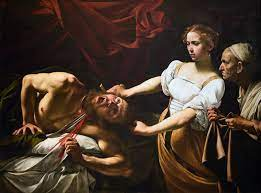Italian painter Michelangelo Merisi da Caravaggio was widely regarded as one of the finest and most influential painters of his time. However, he was also one of the wildest and most carefree artists of all time and may have indirectly influenced his fellow artists to be themselves.
His artwork consisted of violent and controversial themes, including full frontal nudity, homoeroticism, decapitations, and beheadings. However, the high level of realism and intensity of his subjects garnered most of Caravaggio’s fame and sphere of influence.
In his death, a new art movement emerged in tribute to the great artist. The Caravaggisti, as they soon became known, was a relatively small group of followers who adopted both the same controversial themes and the realist Baroque style of Caravaggio’s work.
Judith Beheading Holofernes – Caravaggio
Judith Beheading Holofernes c. 1598 – Caravaggio
Judith Beheading Holofernes is one of Michelangelo Caravaggio’s most recognizable and iconic works. It has been replicated repeatedly and acted as a prevalent theme for many artists throughout the Baroque art period.
The story itself stemmed from a scene from the bible and proved to be one of Caravaggio’s favorites of depicting. The artist was seemingly obsessed with violence and decapitations in particular. This is believed to be because Caravaggio was often in trouble with the law and felt a beheading as one of his possible endings.
In the story, the widow Judith saves her life and the lives of her Israelite people by seducing the invading Assyrian general Holofernes and then cutting off his head with a sword. Caravaggio’s painting is beautifully dark and macabre and perfectly captures the horror and magnitude of the event.
Christ with the Crown of Thorns – Van Barbara
Christ with the Crown of Thorns is one of the most incredible imitations of Caravaggio’s work. It was painted by Dutch artist Dirck Van Barburen and showed just how far across Europe Caravaggio’s influence was able to reach.
It shares aspects from several of Caravaggio’s famous paintings, including The Taking of Christ and Judith Beheading Holofernes, to name just two. In addition, it depicts the biblically inspired scene of Jesus Christ being bound and his head having a crown of thorns placed upon it.
It mirrors the feeling of the Taking of Christ and Judith beheading Holofernes so well that you’d think that it was a Caravaggio painting. It’s a great way to learn about Michelangelo Merisi da Caravaggio. Also, these themes would continue to appear throughout Van Barburen’s collection of work, although he would never quite reach the heights of Caravaggio’s greatness.
Mars Chastising Cupid – Bartolomeo Manfredi
Bartolomeo Manfredi was one of the leading followers of the Caravggisiti during the early 17th century. And there might be a possibility that he may even have been one of his students for a time. Caravaggio undoubtedly influenced the themes and style of his artwork, and his works are some of the closest imitations to Caravaggio that you will find.
Manfredi’s paintings of Mars chastising Cupid are the perfect example of this. It has all the themes usually associated with Caravaggio. The violence, the home-eroticism, the natural body language, and the high level of realism are all present.
In the dramatic painting, the Roman God Mars is whipping Cupid for having caused his affair with Venus, the Goddess of love. In the story, the experience caused Mars to be chastised and shunned by the other Gods, which caused Mars to take out his anger on Cupid. The painting is a representation of anger and a lack of self-control.
Christ and the Adulteress – Valetin de Boulogne
Valentin de Boulogne was a French artist and is an example of the reach of Caravaggio’s influence. Based around Italy, Caravaggio’s style soon reached as far as France and the Netherlands and held significant sway there for a time.
Alongside Manfredi, Valentin is also regarded as one of the most significant followers of the Caravaggisiti style. Valentin studied art in Italy and soon became heavily influenced by Caravaggio and Manfredi.
He also adopted the approach of hiring working-class people to be the models of his paintings, a practice believed to be first started by Caravaggio. These influences are on full display in his painting of Christ and the Adulteress. Caravaggio’s dark themes, realism, and sexual undercurrent are also exquisitely displayed here.
Cain Slaying Abel – Rubens
Another painter heavily inspired by Caravaggio’s work was Flemish artist Peter Paul Rubens. The realism and rawness of some of Rubens’s most famous paintings mirror the tone and themes of Caravaggio’s spirit almost identically.
In many of Rubens’s pieces, there is nudity, there is violence, there are religious parables, and there is a high degree of realism. It is no secret that Rubens was a fan of Caravaggio’s. This influence, alongside painters such as da Vinci and Titan, resulted in the paintings of Rubens being some of the most beautiful constructed compositions ever created.
His striking painting of the scene of Cain slaying his brother Abel is a prime example of Caravaggio’s influence over the Flemish artist. Its unbridled brutishness and biblical theme reflect both the realistic brutality and harshness of the world at its worst and Caravaggio’s similar view.
Conclusion
For Caravaggio, his legacy is more than just the paintings he left behind. The inspiration he inspired was the generation of artists that followed him. Learn more about Michelangelo Merisi da Caravaggio and check out Caravaggio’s complete works online or in a gallery.
